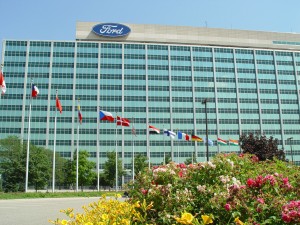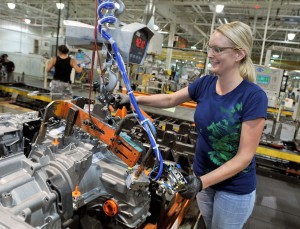Ford Motor Co. expects to distribute profit sharing checks, averaging $7,500, to hourly workers despite the decline in the company’s earnings in 2017.
Ford posted a full-year net income for 2017 of $7.6 billion, which will result in $7,500 profit-sharing checks for an estimated 54,000 hourly workers covered by the United Auto Workers contract, the automaker said.
The profit-sharing checks were roughly $1,500 less than the $9,000 payouts from a year ago and reflected the impact of higher costs for materials, particularly for the aluminum, which is a key ingredient in the company’s F-150 pick-up truck, which is at the heart of the company’s product line and profitability.
Aluminum prices have risen 20% in the last year and nearly 11% since Dec. 11. Steel prices have risen a little more than 9% in the last year. Ford uses more aluminum in its vehicles than its rivals.
(Strong Q4 helps Ford turn $7.6 billion profit in 2017. Click Herefor the story.)
The decline of the size of the profit-sharing checks for UAW drew a perfunctory comment from the union. “Through hard work and collective bargaining in 2015, UAW Ford members will receive an average of $7,500 in profit sharing for their work in 2017,” noted UAW vice president Jimmy Settles, who is the head of the UAW’s Ford Department.
The profit sharing checks for workers at General Motors and Fiat Chrysler Automobiles N.V. are expected to increase this year and FCA CEO Sergio Marchionne has announced plans to pay workers and additional $2,000 bonus from the company’s profits and a reduction in taxes.
(Click Here to see more about Hackett telling analysts Ford cutting car production.)
Ford had offered analysts disappointing earnings outlook for 2017 and 2018 last week and Ford CEO Jim Hackett told an audience that he expected 2018 to be a difficult but the company would push ahead with new investments in autonomous and electric vehicles, while placing more emphasis on trucks and sport utility vehicles while reducing the number of passenger vehicles in the company’s line-up.
Ford Chief Financial Officer Bob Shanks told analysts last week that while the company benefited from low commodity prices in 2016, rising steel prices also have helped drive up the company’s operating costs.
(To see more about Ford’s $11B electrification program, Click Here.)
The Trump Administration is considering whether to impose tariffs on imported steel and aluminum, which could push prices even higher and place a greater burden on companies such as Ford.



I see another bust coming as more and more execs are suffering memory-loss of the 2007 – 09 implosions. Reducing the number of vehicles in the car-lines for right-now high-profit SUVs and Trucks is a bad move. With petrol prices steadily on the rise, wages stagnant and no promise of increasing, it’s a risky gamble.
I mean, just because corporate tax rates are lower it doesn’t mean companies are going to increase wages, hire more people, cause residual industries to hire / raise wages. It’s similar to the banking bail-out; the banks were given billions, with the HOPE they would start lending, which didn’t happen that much or at all at some institutions.